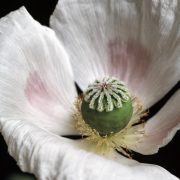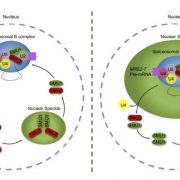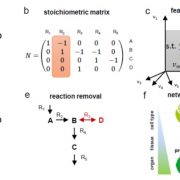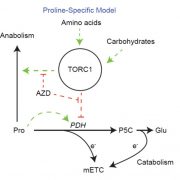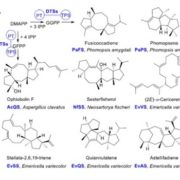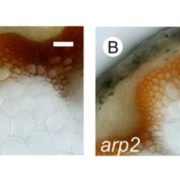Plant Direct Q&A with Joshua Windhalm

What does your lab work on?
We combine functional genomics with synthetic biology approaches to study the metabolism of redox-active plant natural products that can harnessed for applications relevant to agriculture and human health. We are particularly interested in specialized quinones like the notorious allelochemical juglone made by black walnut trees and the anticancer compound shikonin made by the Chinese medicinal plant Lithospermum erythrorhizon. What’s fascinating is that beyond these plants, numerous others—spread across several discrete lineages—have convergently evolved to produce structurally-similar quinones that fulfill various roles in plant-biotic interactions. This suggests that quinones are very effective chemical tools used by plants to interact with other organisms, yet we know little about how they’re made, deployed and used. By understanding these aspects of plant quinone biochemistry, we are working to gain better insight into chemically-mediated plant-biotic interactions and to guide metabolic engineering strategies for producing novel quinone-based natural products, like herbicides and chemotherapeutics.
Tell us about the key findings from your recent article in Plant Direct.
We report—to the best of our knowledge—the first observation of specialized quinones in nectar and their antifungal activities against common nectar fungi. The species we studied, Impatiens glandulifera, is known to produce specialized quinones. Interestingly, one of these compounds, 2-methoxy-1,4-naphthoquinone, is considered an allelochemical that has contributed the invasion success of I. glandulifera in certain parts of Europe and North America. The significance of our study is that we have uncovered evidence to suggest that quinones made by I. glandulifera, and perhaps other flowering plants, may play an additional unsuspected role in influencing the composition of nectar microbial communities. The other finding from our study that we’re really excited about is the detection of quinones in the nectar excreted by I. glandulifera extra-floral nectaries. Quinones made by I. glandulifera have been shown by other groups to be leached via rainfall from aerial parts of the plant into the rhizosphere, although the route by which the compounds first reach the plant surface has remained a mystery. It now appears that extra-floral nectaries may be the conduit by which quinones are deployed from vegetative organs of I. glandulifera.
How did you get the idea to do this study?
Honestly, it was somewhat serendipitous. I started as an Assistant Professor at Purdue in 2016. As soon as I opened the doors to my lab I purchased an HPLC and hired a fantastic lab manager, Elena (Lena) Yakubova. While Lena and I were setting up the lab, we were growing several quinone-producing species and systematically profiling various organs from each to establish what plant systems we wanted to work with for studying specialized plant quinone metabolism. At the time I didn’t really know anything about I. glandulifera. As we grew it, I started noticing these extraordinary “pin-shaped” organs growing out of the leaf nodes and along the leaf edges. I have to admit I had no clue what they were, so I asked one of my new horticulture colleagues who told me they were extra-floral nectaries. Intrigued, I decided to profile them and to my surprise they contained very large pool sizes of quinones. It just so happened that at the time I was preparing a review article on specialized quinone metabolism and functions. I had just come across a paper reporting that structurally-similar quinones secreted into the pitcher traps of carnivorous Nepenthes spp. function as antifungal compounds to protect the digestive fluids. That’s when I started wondering whether the quinones I was detecting in I. glandulifera nectaries might have an analogous role in nectar. To explore this further, I contacted Dr. Anna Block (USDA-ARS-CMAVE) who I knew from my time at the University of Nebraska-Lincoln when I was a graduate student and she was a postdoc. Anna works on various aspects of plant chemical defense and I knew she could help us test the quinones we detected against common nectar microbes.
What do you plan to do next, based on these current findings?
I think there are some pretty obvious follow ups to this study, including determining the microbial composition of I. glandulifera nectaries and then assessing how the reported quinones, both individually and synergistically, affects microbe growth. I think it would also be interesting and definitely worthwhile to further explore the role that the extra-floral nectaries play in releasing allelopathic quinones into the environment. To really get at these questions, however, we need to work with I. glandulifera out in the field where they can interact with pollinators, microbes and other plants. Unfortunately, I. glandulifera has a propensity to spread due to its exploding seed capsules. I’m extremely hesitant to set up my own field experiments with I. glandulifera in an uncontrolled environment as I don’t want to be responsible for it escaping into the area. I’m not aware of any existing nearby populations either (which is a good thing!), but there are known populations in neighboring Michigan where I. glandulifera is on the invasive species watchlist. As my lab becomes more established, I will look for opportunities and funding to study existing populations in other areas in order to get at some of the questions that have emerged from our work.
Why did you choose to publish in Plant Direct?
As I alluded to above, we’ve had to move on from this project for now. We obviously didn’t finish the whole story yet, but I felt we did complete a sound study and made noteworthy observations that could be valuable to others working with I. glandulifera, or with allelopathy or nectar chemistry more broadly. Rather than sit on our findings until we could revisit the work, I decided to submit to Plant Direct. I first considered Plant Direct because it is open access and visible within the plant science community, especially to members of ASPB and SEB. Indeed, after I looked through the Table of Contents I saw that several highly visible scientists in the society communities are publishing in Plant Direct. Plant Direct was also particularly attractive because it is a peer reviewed journal. As an Assistant Professor I need to publish, and it is imperative that my work be critically evaluated by others in the community. So, for all these reasons I decided that Plant Direct was the right forum to disseminate our work.
Publication Spotlight: Block, A. K., Yakubova, E., & Widhalm, J. R. (2019). Specialized naphthoquinones present in Impatiens glandulifera nectaries inhibit the growth of fungal nectar microbes. Plant Direct, 3(5), e00132.
Follow Joshua Windhalm on Twitter


